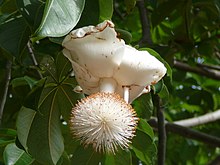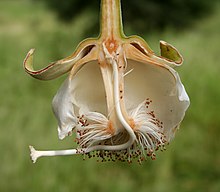User:LoJallen/sandbox
Adansonia digitata, the African baobab, is the most widespread of the baobabs (trees of the genus Adansonia) and is native to the African continent and Southwest Asia (Yemen, Oman). These are long-lived pachycauls; radiocarbon dating has shown some individuals to be over 2000 years old. They are typically found in dry, hot savannas of sub-Saharan Africa, where they dominate the landscape, and reveal the presence of a watercourse from afar. They have traditionally been valued as sources of food, water, health remedies or places of shelter and are steeped in legend and superstition. Common names for the baobab include monkey-bread tree (the soft, dry fruit is edible), upside-down tree (the sparse branches resemble roots), and, because of the powdery fruit pulp, cream of tartar tree.
Description
[edit]




General
[edit]African baobabs are trees that usually grow as solitary individuals, and are large and distinctive elements of savanna or scrubland vegetation. They grow from 5–25 m (16–82 ft) tall.[1] The trunk is typically fluted or cylindrical, often with a buttressed, spreading base.[1] Trunks may reach a diameter of 10–14 m (33–46 ft),[2] but some trees have multiple trunks. The bark is gray and usually smooth. Main branches can be massive. Some call the tree “upside-down” due to the trunk likeness to a taproot and the branches akin to finer capillary roots.
Growth Pattern
[edit]All baobab trees are deciduous, losing their leaves in the dry season, and remaining leafless for about eight months of the year. The trunk is smooth and shiny[3] and can range from being reddish brown to grey. The branches are thick, wide and stout. The span of the roots exceed the tree's height, a factor that enables it to survive in a dry climate.
Leaves
[edit]Leaves are palmately compound in mature trees, but seedlings and regenerating shoots may have simple leaves. The transition to compound leaves comes with age and may be gradual.[1]
Flowers
[edit]During the early summer (September to November in the Southern Hemisphere)[4] the tree bears very large, heavy, white flowers. These are 12 cm (4.7 in) across and open during the late afternoon, staying open for only one night.[5][2] The flowers are pendulous and showy with 5 petals that are leathery and hairy on the inside. The sepals are cup-shaped and 5-cleft. The stamens are divided into multiple anthers and styles are 7-10 rayed. There are a large number of stamens per flower; one from a cultivated tree in Honolulu, Hawai'i had up to 2,267 stamens.[6] Pollen grains are spherical with spikes all over the surface, typical of the Malvaceae family. Size is around 100 microns. The fresh flowers have a sweet scent but after about 24 hrs they start to turn brown, and emit a carrion smell.[5][2] Flowers of A. digitata are primarily pollinated by fruit bats[1] of the subfamily Pteropodinae, but other animals such as bushbabies may also contribute to pollination.[1]
Fruit
[edit]All Adansonia develop large rounded indehiscent fruits with a woody outer coating and internal fleshy pulp.[7] The pulp dries, hardens, and falls to pieces that look like chunks of powdery, dry bread.[8] The seeds are hard, black and kidney-shaped.[5] The outer shell of A. digitata is 6-10 mm thick[7] and may serve to protect the seeds from fires that are frequent in savanna habitats.
Naming
[edit]The scientific name Adansonia refers to the French explorer and botanist, Michel Adanson (1727–1806), who observed a specimen in 1749 on the island of Sor, Senegal.[9] "Digitata" refers to the digits of the hand, as the baobab has compound leaves with normally five (but up to seven) leaflets are akin to a hand.[10] Common names for the baobab include monkey-bread tree (the soft, dry fruit is edible), upside-down tree (the sparse branches resemble roots), and cream of tartar tree (cream of tartar).[11]
Range
[edit]The African Bayobab is found in drier, less tropical climates, is sensitive to water logging and frost and is not found in areas where sand is deep.[12] It is native to mainland Africa. Some references consider it as introduced to Yemen and Oman[13] while others consider it native there.[14] The tree has also been introduced to other regions such as Australia and Asia.[15]
The northern limit of its distribution in Africa is associated with rainfall patterns; only on the Atlantic coast and in the Sudanian Savanna does its occurrence venture naturally into the Sahel. On the Atlantic coast, this may be due to spreading after cultivation. Its occurrence is very limited in Central Africa, and it is found only in the very north of South Africa. In Eastern Africa, the trees grow also in shrublands and on the coast. In Angola and Namibia, the baobabs grow in woodlands, and in coastal regions, in addition to savannas.[16]
The African Bayobab is native to Mauritania, Senegal, Guinea, Sierra Leone, Mali, Burkina Faso, Ghana, Togo, Benin, Niger, Nigeria, northern Cameroon, Chad, Sudan, Congo Republic, DR Congo (formerly Zaire), Eritrea, Ethiopia, southern Somalia, Kenya, Tanzania, Zambia, Zimbabwe, Malawi, Mozambique, Angola, São Tomé, Príncipe, Annobon, South Africa (in Limpopo province, north of the Soutpansberg mountain range), Namibia, Botswana.[13][17] It is an introduced species in Java, Nepal, Sri Lanka, Philippines, Jamaica, Puerto Rico, Haiti, Dominican Republic, Venezuela, Seychelles, Madagascar, Comoros, India, Guangdong, Fujian, Yunnan.[13] and has been planted in Penang, Malaysia, along certain streets.[18]
- ^ a b c d e Baum, D.A., 1995, A Systematic Revision of Adansonia (Bombacaceae). Annals of the Missouri Botanical Garden , 1995, Vol. 82, No. 3 (1995), pp. 440-471
- ^ a b c "Baobab (Adansonia digitata) - Information on Baobab - Encyclopedia of Life". Encyclopedia of Life. Retrieved 17 May 2015.
- ^ "Boabab Tree - Southern African Trees - Adansonia digitata". krugerpark.co.za. Retrieved 17 May 2015.
- ^ Sheehan, Sean (2004). Zimbabwe (Vol. 6 of Cultures of the World) (2nd ed.). New York: Benchmark Books/Marshall Cavendish. p. 13. ISBN 9780761417064.
- ^ a b c Cite error: The named reference
hankwas invoked but never defined (see the help page). - ^ Counted on a naturally fallen flower at Foster Botanic Garden, Honolulu on June 24, 1987
- ^ a b Kempe et al. 2018. Adansonia digitata and Adansonia gregorii fruit shells serve as a protection against high temperatures experienced during wildfires. Bot Stud (2018) 59:7 https://doi.org/10.1186/s40529-018-0223-0
- ^ National Research Council (January 25, 2008). "Baobab". Lost Crops of Africa: Volume III: Fruits. Lost Crops of Africa. Vol. 3. National Academies Press. doi:10.17226/11879. ISBN 978-0-309-10596-5. Retrieved July 15, 2008.
- ^ "Michel Adanson - Poudre Baobab bio - acheter poudre baobab bio". baobab.com. Retrieved 17 May 2015.
- ^ du Plessis, Doep (November 2011). "Die Thabazimbi-bosveld se groot kremetart" (PDF). Dendron (43): 11. Archived from the original (PDF) on 4 March 2016. Retrieved 25 November 2015.
- ^ "Monkey-bread tree (Adansonia digitata) | spotwild". spotwild.org. Retrieved 2020-05-29.
- ^ "Descriptions and articles about the Baobab (Adansonia digitata) - Encyclopedia of Life". Encyclopedia of Life. Retrieved 17 May 2015.
- ^ a b c "Catalogue of Life - Adansonia digitata L." catalogueoflife.org. Retrieved 29 August 2017.
- ^ Cite error: The named reference
kewwas invoked but never defined (see the help page). - ^ "Curious Kimberley: Scientists disagree how boab trees got to Australia from Africa and Madagascar - ABC News". www.abc.net.au. August 6, 2018.
- ^ "Adansonia digitata:Plant Database of India". Archived from the original on 26 August 2011. Retrieved 21 March 2011.
- ^ "Descriptions and articles about the Baobab (Adansonia digitata) - Encyclopedia of Life". Encyclopedia of Life. Retrieved 17 May 2015.
- ^ Simon Gardner, Pindar Sidisunthorn and Lai Ee May, 2011. Heritage Trees of Penang. Penang: Areca Books. ISBN 978-967-57190-6-6

